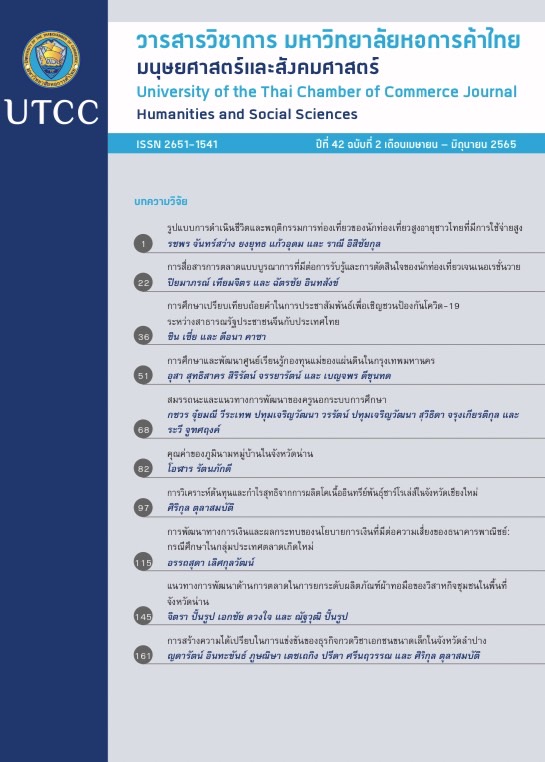A Comparative Study of Publicizing Utterances for Inviting to Prevent COVID-19 between P.R. China and Thailand
Main Article Content
Abstract
This article aims to compare the content and linguistic strategies that appear in the publicizing utterances for inviting to prevent COVID-19 between Chinese and Thai. Researchers collected Chinese language data in public areas in Sichuan Province P.R. China, while Thai language data was collected from the website of the Ministry of Public Health of Thailand, a total of 86 data were analyzed by the Content Analysis and Pragmatics. The results showed that Chinese data and Thai data share some same features and have some unique features on Content and Linguistic Strategies, which could reflect some differences in social culture between China and Thailand. For example, do use serving chopsticks for Chinese people, while do not to take a meal face to face for Thai people, and family members matter a lot for Chinese people, while Thai people are interested in “merit”. There are 3 linguistic strategies including speech acts, metaphors, and modality. Both Chinese and Thai use orders, invitations; reasoning was found only in Chinese, while requests, advice, and warnings were found only in Thai. The metaphor COVID-19 IS ENEMY and PREVENTING FROM COVID-19 IS WARM TEMPERATURE appears in both Chinese and Thai. However Chinese still use metaphor NOT PROTECTING FROM COVID-19 IS TRAVELING TO A BAD DESTINATION. Chinese use only one kind of modality: must, while Thai has a wider choice of modalities: must, should, may.
Article Details

This work is licensed under a Creative Commons Attribution-NonCommercial-NoDerivatives 4.0 International License.
ลิขสิทธิ์ของบทความ
ผลงานที่ได้รับการตีพิมพ์ถือเป็นลิขสิทธิ์ของมหาวิทยาลัยหอการค้าไทย ห้ามมิให้นำเนื้อหา ทัศนะ หรือข้อคิดเห็นใด ๆ ของผลงานไปทำซ้ำ ดัดแปลง หรือเผยแพร่ ไม่ว่าทั้งหมดหรือบางส่วนโดยไม่ได้รับอนุญาตเป็นลายลักษณ์อักษรจากมหาวิทยาลัยหอการค้าไทยก่อน
References
ธนพล เอกพจน์, วิรัช วงศ์ภินันท์วัฒนา, และปานปั้น ปลั่งเจริญศรี. (2020). ไวรัสโคโรนาสายพันธุ์ใหม่ 2019 คือ ศัตรู: การศึกษาอุปลักษณ์เชิงมโนทัศน์ของคนไทย ตามแนวภาษาศาสตร์ปริชาน. วารสารภาษา ศาสนา และวัฒนธรรม, 9(1), 1-37.
นันทนา วงษ์ไทย. (2563). ภาษาและความหมาย (พิมพ์ครั้งที่ 3). กรุงเทพฯ: เค.ซี.อินเตอร์เพรส.
พงษ์ วิเศษสังข์. (2010). ความรู้เบื้องต้นเกี่ยวกับการสื่อสาร (พิมพ์ครั้งที่ 10). กรุงเทพฯ: มหาวิทยาลัยกรุงเทพ.
Chen, C., Zou, W., Hu, Z., Huang, X., Shuai, C., Le, W., … Huang, X. (2020, September 10). 人民至上 生命至上. Xinhua Daily Telegraph. Retrieved from http://www.xinhuanet.com/mrdx/2020-09/11/c_139361578.htm?ivk_sa=1024320u
Ding, Y., Wang, J., & He, L. (2021). 疫情下宣传标语的言语行为分析. Journal of News Research, 12(6), 50-51.
Hu, Y. (2021). Health mobilization of the epidemic prevention slogan: Discourse strategy, framework and power structure. Journal of International Communication, 43(5), 86-105.
Lakoff, G., & Johnson, M. (1980). Metaphor we live by. Chicago, IL: University of Chicago Press.
Li, L. (2020). Research of publicity slogans on epidemic prevention under the background of the battle against COVID-19. Journal of Changzhi University, 37(3), 17-21.
Peng, X. (2020). 语用预设视角下新冠肺炎防疫标语探析. Wenjiaoziliao, (35), 7-10.
Saeed, J. I. (2009). Semantics (3rd ed.). Malden, MA: Wiley-Blackwell.
Searle, J. R. (1969). Speech acts: An essay in the philosophy of language. Cambridge, MA: Cambridge University Press.
Wang, X. (2020). On value and significance of local literature in the new era to rural rejuvenation. Journal of Shanxi Datong University, 34(2), 109-114.


